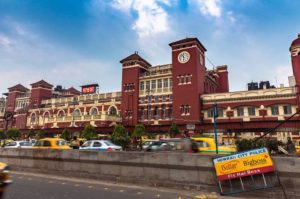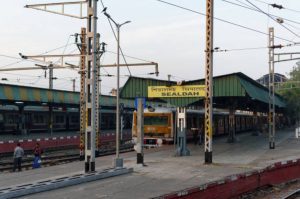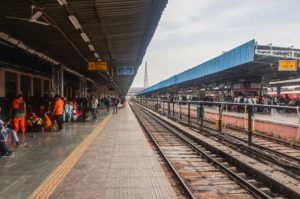West Bengal to Witness Railway Renaissance: The Indian Railways is undergoing a monumental transformation under the ambitious Amrit Bharat Station Scheme (ABSS), a visionary project initiated by the Government of India to modernize and redevelop railway stations across the country. The initiative is designed not only to upgrade the nation’s railway infrastructure but also to enhance the overall travel experience for millions of daily commuters. At its core, the ABSS aims to introduce modern passenger amenities, integrate state-of-the-art infrastructure, and reflect the rich cultural and architectural heritage of India through station design.
As part of this nationwide overhaul, West Bengal has emerged as a key beneficiary, with 37 railway stations across the state earmarked for redevelopment. The Union Government has sanctioned a significant sum of Rs.1,503 crore for the modernization of these stations. This move is expected to revolutionize the railway landscape of the state, improve passenger facilities, stimulate regional growth, and boost tourism.

West Bengal to Witness Railway Renaissance: What is the Amrit Bharat Station Scheme?
Launched by the Ministry of Railways, the Amrit Bharat Station Scheme is a long-term policy aimed at transforming more than 1,300 railway stations across India. The initiative adopts a master planning approach to station development, with a focus on seamless integration of transportation systems, modern amenities, eco-friendly designs, and improved accessibility.
The scheme goes beyond cosmetic upgrades. It envisions creating railway stations that serve as multifunctional urban hubs, where infrastructure not only caters to the needs of travelers but also complements city development. The foundation stone for redevelopment of 508 stations was virtually laid by Prime Minister Narendra Modi in 2023, underlining the Centre’s commitment to modernizing India’s transport backbone.
The total projected investment for these 508 stations across India stands at a staggering Rs.24,470 crore, with West Bengal playing a vital role in this transformation.
West Bengal’s Share: 37 Stations to Be Redeveloped
In West Bengal, 37 stations are slated to be redeveloped under the ABSS. These include some of the busiest junctions and critical transit points in the state. Among the most prominent are:
-
Sealdah Station – One of India’s busiest terminals, handling over a million passengers daily.
-
Malda Town
-
Bolpur (Shantiniketan)
-
Barddhaman Junction
-
New Alipurduar
-
New Mal Junction
-
Tarakeswar
-
Rampurhat Junction
Each of these stations is set to receive a comprehensive overhaul tailored to its geographic and cultural context, passenger volume, and strategic importance.
Key Redevelopment Features Under ABSS
The station redevelopment process under the Amrit Bharat Station Scheme in West Bengal includes three primary components:
1. Modern Passenger Amenities
One of the scheme’s foremost objectives is to significantly enhance the passenger experience. The stations will be outfitted with:
-
Spacious and well-ventilated waiting halls
-
High-quality restrooms with modern sanitation systems
-
Digital ticketing and information kiosks
-
LED signage boards for real-time updates
-
Drinking water points, food courts, and child-friendly areas
-
Escalators and elevators to assist senior citizens and differently-abled passengers
The goal is to make stations comfortable, efficient, and safe, aligning with international standards.
2. Infrastructure Enhancements
From the construction of new buildings to platform extensions and inter-modal transport facilities, the scheme will introduce:
-
New station facades featuring traditional designs fused with modern materials
-
Platform shelters with solar roofing for energy efficiency
-
Foot overbridges (FOBs) and subways to ensure safe passenger flow
-
Separate arrival and departure corridors
-
Improved parking and pick-up zones
-
Integration with bus depots, taxi bays, and metro lines where applicable
These changes are intended to reduce congestion, streamline operations, and accommodate increasing footfall in the future.
3. Cultural and Aesthetic Integration
To preserve and showcase regional identities, the architectural style of each redeveloped station will incorporate local culture and history. For instance:
-
Sealdah Station may include architectural motifs inspired by Kolkata’s colonial-era buildings.
-
Bolpur Station, located near the culturally rich Shantiniketan, will likely showcase Bengali tribal art and Tagorean aesthetics.
-
Stations in North Bengal may feature design elements reflecting hill architecture or tea garden culture.
This fusion of modernity and tradition ensures that stations not only serve functional purposes but also become cultural touchpoints.
Why This Matters: Economic and Social Implications
The Amrit Bharat Station Scheme goes beyond just beautification. It’s part of a larger vision to boost India’s economic resilience, especially in states like West Bengal, where railway connectivity plays a crucial role in commerce and tourism.
Employment Generation
The redevelopment process itself is expected to create thousands of jobs—both skilled and unskilled. From construction workers and engineers to retail operators and maintenance staff, the revamped stations will act as economic ecosystems.
Boost to Tourism and Local Economy
Stations like Bolpur, Tarakeswar, and Rampurhat are gateways to major tourist and religious destinations. With enhanced facilities, these locations can expect a surge in footfall, translating into increased revenue for local businesses, hotels, and transport services.
Urban Revitalization
Many of these stations lie in the heart of busy urban centers. Their redevelopment will contribute to urban renewal by decluttering congested zones, improving pedestrian access, and creating better road-rail integration.
West Bengal’s Rail Heritage Meets the Future
West Bengal has always held a prominent place in the Indian railway narrative. From the Howrah Station, one of India’s oldest and busiest terminals, to the Darjeeling Himalayan Railway, a UNESCO World Heritage site, the state boasts a rich railway legacy. With the ABSS, this legacy is set to meet the future through world-class facilities and futuristic planning.
For example:
-
Howrah Station (though part of a different scheme) is being redeveloped as a multi-modal hub, integrating metro, ferry, and bus services.


-
Sealdah Station under ABSS is being modeled to handle future traffic with ease, potentially including bullet train linkages in future phases.

Challenges and Monitoring
Large infrastructure projects in India often face hurdles—land acquisition delays, contractor issues, or bureaucratic red tape. To avoid this, the Railway Ministry has implemented:
-
Strict monitoring protocols
-
Real-time dashboards
-
Monthly reviews at zonal and divisional levels
In West Bengal, the Eastern Railway and Northeast Frontier Railway zones have been entrusted with timely execution of the projects. PM Modi’s office and the Railway Board are closely tracking progress.
Public Reactions and Stakeholder Feedback
Initial public response to the announcements has been positive. Commuters, traders, and civic bodies have welcomed the initiative, especially in smaller towns where stations have lacked basic facilities for decades.
However, some have raised concerns over:
-
Heritage conservation—particularly in stations like Barddhaman or Malda Town
-
Disruption during construction
-
Accessibility gaps for the elderly during transition phases
Railway officials have assured that all designs are being vetted for inclusivity and heritage-sensitive development.
A Transformative Journey Ahead
The Amrit Bharat Station Scheme in West Bengal marks a turning point in how Indian Railways interacts with its passengers and how infrastructure shapes societal progress. From facilitating smoother daily commutes to enhancing long-distance travel, from cultural integration to urban revitalization, the scheme is more than just a policy—it is a transformative journey.
As these 37 stations undergo a metamorphosis, West Bengal stands on the cusp of becoming a model for modern, passenger-centric, and culturally rich railway infrastructure in India.
External References (Do Follow)
Also read: Home | Channel 6 Network – Latest News, Breaking Updates: Politics, Business, Tech & More


